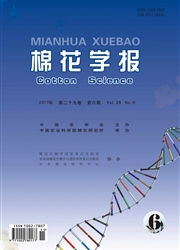

 中文摘要:
中文摘要:
用带PBI121质粒的农杆菌LBA4404菌株转化泗棉3号胚性愈伤组织,获得的再生植株进一步对gus和nptⅡ基因进行PCR跟踪检测,共得到97株阳性转基因植株。GUS组织化学检测发现,97株转基因幼苗中有10株GUS检测阴性,嫁接后,只成活一株。利用来源于同一愈伤系的GUS检测阳性植株作为对照,对这一GUS检测阴性的植株进行gus基因沉默机理研究。Southern分析表明,该GUS检测阴性植株与GUS检测阳性植株有相同拷贝数。GUS组织化学检测和RT—PCR分析显示,gus基因在GUS检测阴性植株中没有表达,而nptⅡ基因在这两株转基因棉花中都表达。用限制性内切酶-PCR法分析35S启动子区甲基化发现:GUS检测阴性植株35S启动子区TATA box的HapⅡ/MspⅠ酶切位点发生甲基化,而GUS检测阳性植株该位点没有甲基化。以上研究表明,这株gus沉默的转基因棉花可能是由于其35S启动子区甲基化引起的。
 英文摘要:
英文摘要:
In this report, we found that transgenes were inactived during the transformation of cotton mediated by Agrobacterium, and we studied the mechanism of inactivation. Cotton embryogenic calli (EC) were transformed by Agrobacterium strain LBA4404 possessing the pBI121 binary vector. Ninety-seven transgenic plantlets were identified by PCR amplification for gus reporter gene and npt-Ⅱ selection marker gene. Among the 97 transgenic plantlets, 10 (about 10%) gus inactive individuals were detected. After grafting the transgenic plantlets in the greenhouse, only one GUS-negative plant survived. In an effort to study the silencing mechanism of the GUS-negative transgenic plant, a GUS- positive plant generated from a single calli line was chosen for comparisons. Southern analysis revealed that the two transgenic plants possessed the same insertion copy numbers, and they had the same transformation event. GUS assay and RT-PCR analysis indicated that gus was silenced in the GUS-negative plant but it was expressed in the GUS-positive plant; while RT-RCR detection showed that the npt-Ⅱ gene expressed in both transgenic plants. Restriction endonuclease-PCR analysis of methylation in the 35S promoter was conducted by using of the methylation-sensitive enzymes HapⅡ/ MspⅠ. The results demonstrated that the HapⅡ site in the TATA box of the 35S promoter region was methylated in the gus inactive transgenic plant and not in the gus active plant, which indicated that methylation of the 35S promoter caused gus silencing in transgenic cotton plants. This study represents the first report of transgenic silencing mechanisms in cotton transformation mediated by Agrobacterium.
 同期刊论文项目
同期刊论文项目
 同项目期刊论文
同项目期刊论文
 期刊信息
期刊信息
